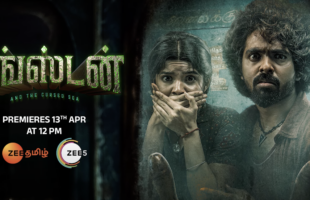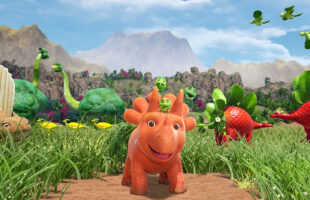Set in the near future, Defiance introduces an exotically transformed planet Earth, its landscapes permanently altered following the sudden and tumultuous arrival of seven unique alien races, and the newly-formed civilisation of humans and aliens must learn to co-exist peacefully in the boom-town of Defiance, which sits atop the ruins of St. Louis, Missouri. The series stars Grant Bowler, Julie Benz, Stephanie Leonidas, Tony Curran, Jaime Murray, Graham Greene and Mia Kirshner.
The multi-player open world video game (released for Microsoft Windows, PlayStation 3 and Xbox 360 two weeks before the TV premiere) allows viewers to participate in scenarios related to the events that take place in the show. “There are things that look like they’re spontaneous that the gamers will play. In the pilot, there’s a little gadget that (characters) Nolan and Irisa have when they’re opening up the Ark. If you’ve actually played the game, that gadget has enormous significance from the game play… In the game you’ll help them get that gadget. But you’re going to get that gadget, no matter what, because it enters the TV series, regardless. So it looks spontaneous,” explains Mark Stern, President, Original Content, Syfy, on how the game works.
For the gaming component of the project, Syfy partnered with American video game developer and publisher Trion Worlds (known for Rift, the Massively Multiplayer Online Role-Playing game released in 2011 that has grossed more than US$100 million) to develop a state-of-the-art gaming platform. “Trion’s dynamic technology enables us to build interactive storylines that impact the TV series and the game in both big and small ways,” says Dave Howe, President, Syfy and Chiller.
Executive Producer Kevin Murphy discusses the inspiration for meshing both mediums of television and gaming.
“I grew up just as a gigantic comic book geek. What I always loved about comics was the fact that you could love Batman and read Batman’s Adventures, and Batman’s Adventures would stand on their own and be a satisfying reading experience. And if you happened to also like Superman, you could read Superman. When they would have their occasional crossover, like in the summer where they’d share adventures in the Justice League, it would add this extra layer of coolness to the whole thing,” says Murphy. “But you could choose what it is you have. And I think that that’s kind of an analogy of what we’re doing here because the Trion game has its own narrative. It has its own storylines.”
The project, according to Howe, was designed with the game in mind from the very start. “The rich immersive mythology of Defiance has been conceived to play out on two different platforms that share the same characters, aesthetics, environments, and technologies. Each platform is designed as a self contained and stand-alone experience, but together they’re that much more powerful, offering complementary interactive storytelling that unfolds across both platforms.”
Stern reinforces Howe’s comments on both platforms’ independent narratives. “When we set out with Trion, both companies agreed that we were going to do the best show or game that we could do, period, that you didn’t need to know anything about one to enjoy the other,” says Stern. “So if you know about both, it helps the experience and it adds to it.”
However, securing the rights to produce content for both platforms proved to be challenging. “As the lawyers will tell you, it was very elaborate because you had to cover rights that you wouldn’t normally have to cover. And lawyers love that; non-precedential deals. And the agents, even more so. In fact, Grant (Bowler) and Stephanie (Leonidas) are in the game. Their avatars are in the game. So we needed to make sure that we covered all those rights,” says Stern.
Despite the challenges involved in rights clearance, Howe says that Defiance’s cross-platform potential was ultimately what attracted the network to commission the project. “Five years ago at Syfy, we had a vision. And as we like to do, we ‘imagined greater’. We imagined the future of entertainment as technology evolves across new digital screens and platforms. Our vision was simply to create true transmedia properties, and that means characters and stories that are designed and built, from the get go, to live on these various new platforms.”








